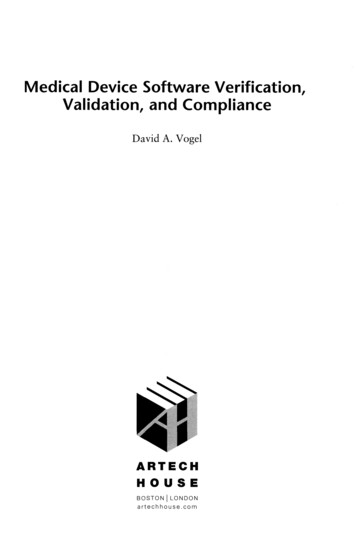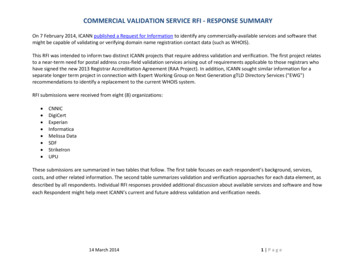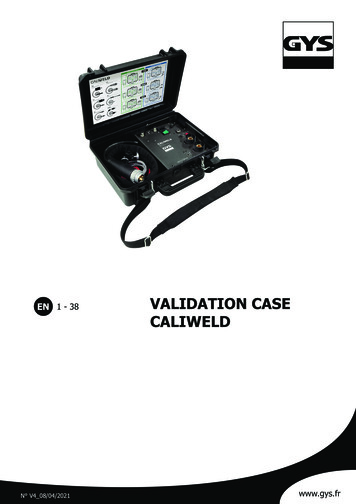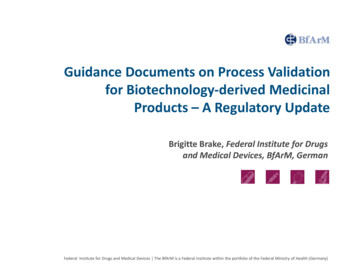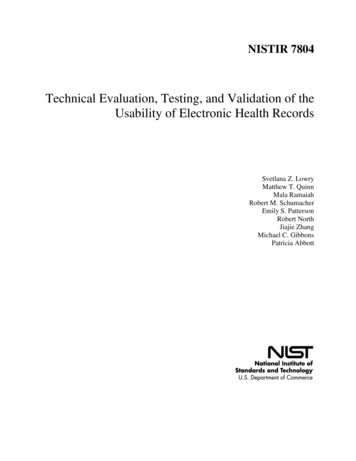
Transcription
NISTIR 7804Technical Evaluation, Testing, and Validation of theUsability of Electronic Health RecordsSvetlana Z. LowryMatthew T. QuinnMala RamaiahRobert M. SchumacherEmily S. PattersonRobert NorthJiajie ZhangMichael C. GibbonsPatricia Abbott
NISTIR 7804Technical Evaluation, Testing, and Validation of theUsability of Electronic Health RecordsSvetlana Z. LowryMatthew T. QuinnMala RamaiahNational Institute of Standards and TechnologyRobert M. SchumacherUser Centric, Inc.Emily S. PattersonOhio State UniversityRobert NorthHuman Centered Strategies, LLCJiajie ZhangUniversity of Texas – HoustonMichael C. GibbonsPatricia AbbottJohns Hopkins UniversityFebruary 2012U.S. Department of CommerceJohn E. Bryson, SecretaryNational Institute of Standards and TechnologyPatrick D. Gallagher, Under Secretary for Standards and Technology and Director2
AcknowledgmentsThe authors gratefully acknowledge the contributions of Ronald Kaye (Food and Drug Administration),Molly F. Story (Food and Drug Administration), Quynh Nhu Nguyen (Food and Drug Administration),Ben-Tzion Karsh (University of Wisconsin-Madison), Muhammad Walji (University of Texas-Houston),Debora Simmons (University of Texas-Houston), Ben Shneiderman (University of Maryland), David H.Brick (Medical School New York University), Kirsten Jerch (User Centric), Janey Barnes (User View), AmyFranklin (University of Texas-Houston), Krisanne Graves (University of Texas-Houston), and Emile Morse(National Institute of Standards and Technology) to the development and expert review of this report.The authors appreciate the many informative comments from a broad spectrum of stakeholders on theDraft Electronic Health Record (EHR) Usability Protocol (EUP) during the public comment period, as wellas numerous reviewers for their constructive feedback on prior drafts of the document.Disclaimer: Certain commercial entities, equipment, or materials may beidentified in this report in order to describe an experimental procedure orconcept adequately. Such identification is not intended to implyrecommendation or endorsement by the National Institute of Standards andTechnology, nor is it intended to imply that the entities, materials, orequipment are necessarily the best available for the purpose.3
Table of ContentsTable of Contents . 41Executive Summary . 72Concept for an EHR Usability Protocol (EUP). 102.1 General Approach . 122.2 EUP Foundation: Research Findings Defining EHR Usability Issues and Their Impact on Medical Error(EHR Patient Safety Model) . 132.4 What the EHR Usability Protocol Is Not . 293 Step I: EHR Application Analysis . 303.13.23.33.43.54Step II: EHR Interface Expert Review . 324.14.24.34.45Overview of Interface Expert Review Process . 32Overview of Design Principles Used in Reviews . 32Selection and Composition of the Review Team . 33Review Process Overview . 34Step III: EHR User Interface Validation Test . 365.15.26Describe Application Scenarios of Use, User Tasks, and Application Interface Interaction . 30Define and Describe Application User Groups . 30Describe Application Environment of Use . 30Identify Critical Safety-Related Tasks . 30Formative and/or Preliminary Usability Assessment Overview . 31Purpose of Summative Validation Testing and General Approach. 36Overview of Validation Testing Steps . 40Conclusion . 57Appendix A: Government Best Practices of Human-System Integration. 58Appendix B: Form for Expert Review . 64Expert Review of EHR . 65The system should protect the user and patient from potential use errors. Items 1A through 1H are principlesof good design that help identify areas that might engender use error in EHRs. Items 2-13 are generalprinciples of good user interface design. . 661A. Patient identification error. 66Actions are performed for one patient or documented in one patient’s record that were intended for anotherpatient. . 661B. Mode error . 68Actions are performed in one mode that were intended for another mode. 681C. Data accuracy error. 69Displayed data are not accurate. 691D. Data availability error . 71Decisions are based on incomplete information because related information requires additional navigation,access to another provider’s note, taking actions to update the status, or is not updated within a reasonabletime. 711E. Interpretation error . 72Differences in measurement systems, conventions and terms contribute to erroneous assumptions about themeaning of information. . 724
1F. Recall error . 73Decisions are based on incorrect assumptions because appropriate actions require users to rememberinformation rather than recognize it. . 731G. Feedback error . 74Decisions are based on insufficient information because lack of system feedback about automated actionsmakes it difficult to identify when the actions are not appropriate for the context. . 741H. Data integrity error . 75Decisions are based on stored data that are corrupted or deleted. . 752. Visibility of System Status . 76The system should always keep the user informed about what is going on, through appropriate feedbackwithin reasonable time. . 763. Match between System and the Real World . 77The system should follow the user’s language, with words, phrases and concepts familiar to the user, ratherthan system-oriented terms. Follow real-world conventions, making information appear in a natural andlogical order. . 774. User Control and Freedom . 78Users should be free to select and sequence tasks (when appropriate), rather than having the system do this forthem. Users often choose system functions by mistake and will need a clearly marked “emergency exit” toleave the unwanted state without having to go through an extended dialogue. Users should make their owndecisions (with clear information) regarding the costs of exiting current work. The system should support undoand redo. 785. Consistency and Standards . 79Users should not have to wonder whether different words, situations or actions mean the same thing. Followplatform conventions. 796. Help Users Recognize, Diagnose and Recover From Errors . 80Error messages should be expressed in plain language (NO CODES). . 807. Error Prevention . 81Even better than good error messages is a careful design that prevents a problem from occurring in the firstplace. 818. Recognition Rather Than Recall . 82Make objects, actions and options visible. The user should not have to remember information from one part ofthe dialogue to another. Instructions for use of the system should be visible or easily retrievable wheneverappropriate. . 82Accelerators-unseen by the novice user-may often speed up the interaction for the expert user such that thesystem can cater to both inexperienced and experienced users. Allow users to tailor frequent actions. Providealternative means of access and operation for users who differ from the “average” user (e.g., physical orcognitive ability, culture, language, etc.) . 8310. Aesthetic and Minimalist Design. 84Dialogues should not contain information that is irrelevant or rarely needed. Every extra unit of information ina dialogue competes with the relevant units of information and diminishes their relative visibility. . 8411. Help and Documentation . 85Even though it is better if the system can be used without documentation, it may be necessary to provide helpand documentation. Any such information should be easy to search, focused on the user’s task, list concretesteps to be carried out, and not be too large. . 8512. Pleasurable and Respectful Interaction with the User . 86The user’s interactions with the system should enhance the quality of her or his work-life. The user should betreated with respect. The design should be aesthetically pleasing- with artistic as well as functional value. . 865
13. Privacy . 87The system should help the user to protect personal or private information belonging to the user or his/herpatients. . 87Appendix C: Scenario 1: Ambulatory Care – Chronic Complex Patient; Mid-Level Provider 88Appendix D: Scenario 2: Inpatient Care – Cardiac Patient; Physician . 91Appendix E: Scenario 3 Critical Care – Cardiac Patient; Nurse . 94Appendix F: Recruitment Screener Adapted from NISTIR 7742 . 95Appendix G: Example Tester’s Guide . 98Appendix H: Informed Consent and Non-Disclosure Forms Adapted from NISTIR 7742 . 105Appendix I: Usability Ratings. 108Appendix J: Incentive Receipt and Acknowledgment Form . 109Glossary of Acronyms . 110Further Reading. 1116
1Executive SummaryThis document summarizes the rationale for an Electronic Health Record (EHR) Usability Protocol (EUP)and outlines procedures for design evaluation and human user performance testing of EHR systems. Theprocedures include general steps and guidance for evaluating an EHR user interface from clinical andhuman factors perspectives, and for conducting a validation study (i.e., summative usability test) of EHRuser interfaces with representative user groups performing realistic tasks.The document begins with a brief overview of the context for this guidance: Why is EHR usabilitycritical? Usable EHRs have the potential to reduce “use errors” and improve patient care. 1 TheInternational Organization for Standardization’s definition of usability is “The extent to which a productcan be used by specified users to achieve specified goals with effectiveness, efficiency, and satisfactionin a specified context of use.” 2 The purpose of this proposed usability protocol is to encourage usercentered development processes focused on safety by facilitating the design of EHR interfaces withgood usability. The authors of this document seek to make EHRs safer by providing methods to measureand validate user performance prior to deployment. Moreover, the authors hope to encourage systemdevelopers to apply human factors best practices and incorporate user-centered design processes intothe development and deployment of EHR systems. Such practices and processes have a proven recordin industries such as aviation, military systems, transportation, and nuclear power.We include a detailed description of research findings relating to usability issues and their relationshipto patient safety. This research has resulted in the development of a model for understanding therelationship between usability and patient safety outcomes, presented in Section 2 of this document.This model provides the foundation for the evaluation and testing process outlined in the EUP.The EUP is a three-step process represented in Figure 1: (1) EHR Application Analysis, (2) EHR UserInterface Expert Review, and (3) EHR User Interface Validation Testing (See Figure 1).1“Use error” is defined by ANSI/AAMI HE75 as “an act or omission of an act that has a different result to that intended by themanufacturer or expected by the operator.” It is a term used very specifically to refer to cases where poorly designed userinterfaces cause users to make errors of commission, where actions are erroneously taken, or errors of omission, where actionsare erroneously omitted. It is true that human error can and does occur, but many errors are attributable not to the user per sebut rather to designs that are flawed, e.g., poorly written messaging, misuse of color-coding conventions, omission of relevantinformation, etc.2ISO/IEC. (1998). Ergonomic requirements for office work with visual display terminals (VDT)s - Part 14 Menu dialogue (ISO/IEC9241-14).7
Figure 1. EUP Three-Step ProcessEHR Patient SafetyModelStep I: EHRApplication AnalysisEHR UserInterfaceCritical SafetytestScenariosIdentifycritical userisksStep III. EHRValidation TestingStep II. EHR InterfaceExpert ReviewIdentify UIdesign issues &iterate designDescriberemaining UIissuesFinal EHRUserInterfaceStep 1: EHR Application Analysis: The Application Analysis is both a key component of user-centereddevelopment processes 3 and the foundation for the EUP and all subsequent analysis and testingactivities. The Application Analysis can rely heavily, where applicable, on the EHR applicationdeveloper’s user requirements and system requirements analysis. These elements include a descriptionof the application’s basic functions, analysis of the user characteristics, task analysis describing theinteractions between users and the application, analysis of the anticipated environment of use relatedto interactions with the application, and the identification of critical user tasks related to aspects ofpatient safety. A basic description of the application’s user interface should also be included in this stepto facilitate the process of the subsequent EHR Interface Expert Review (Step 2). The ApplicationAnalysis should provide a description of the design of the application’s user interface and how thedesign has been optimized via iterative formative and exploratory usability assessments duringdevelopment.3“NIST Guide to the Processes Approach for Improving the Usability of Electronic Health Records” (NISTIR 7741)provides NIST guidance for those developing electronic health record (EHR) applications following user-centereddesign (UCD) processes. An established UCD process ensures that EHRs are efficient, effective, and satisfying to theuser. The main purpose of this guide is to provide practical guidance on methods relating to UCD and usabilitytesting. The intended audiences of this document are those with a role in determining the features and functionscontained in the EHR and how those are represented in the user interface.8
Step 2: EHR User Interface Expert Review: The Expert Review is conducted by a combination of thevendor’s development team and a dedicated team of clinical safety and usability experts. The evaluatorscompare the EHR’s user interface design to scientific design principles and standards, and identify designissues that could lead to safety risks. Subsequent to this review, the application developer may chooseto modify aspects of the application’s user interface to eliminate problems or departures from acceptedbest practice that are related to patient safety issues.Step 3: EHR User Interface Validation Test: The Validation Test evaluates actual user performance oncritical patient safety-related tasks identified in the previous steps, including a validation test conductedby qualified usability/human factors professionals prior to EHR implementation/deployment.Performance is examined by collecting user performance data that are relevant indicators of thepresence of safety risks. These measures may include, but are not limited to, objective measures ofsuccessful task completion, number of errors and corrected errors, performance difficulties, and failuresto complete the task successfully or in proper sequence. Performance is also evaluated by conductingpost-test interviews focused on what users identify as risks based on confusion or misunderstandingwhen carrying out directed scenarios of use. The goal of the validation test is to make sure that criticalinterface design issues are not causing patient safety-related use error; in other words, that theapplication’s user interface supports error-free user interaction. Sample forms for test scenarios areprovided in the appendices as examples only; the development and test teams will develop otherscenarios and modify these examples as necessary for their medical context.The balance of this document summarizes research findings on the relationship between usability andpatient safety applicable to EHRs, and describes the overall EUP in detail (with examples of supportingdocuments provided in appendices). It is our expectation that the potential for use errors can beidentified and mitigated by using the EUP.9
2Concept for an EHR Usability Protocol (EUP)EHRs offer great promise for improving healthcare processes and outcomes, including increased patientsafety. Emerging evidence suggests that the use of health information technology (HIT) may helpaddress significant challenges related to healthcare delivery and patient outcomes. 4 For example, threerecent reports suggest that the use of HIT may improve healthcare outcomes 5 and reduce patientmortality. 6 In addition, the use of HIT is a key component of a national strategy to improve healthcarequality and patient safety. 7 We anticipate that over the next few years, experience with meaningful useof EHRs in hospital and outpatient settings will grow rapidly. Given the estimate that one in threepatients will potentially be harmed during hospitalization, 8 the potential for using EHRs to improvepatient safety may be significant.On the other hand, a prior study found that patient mortality unexpectedly increased following theintroduction of an EHR in a pediatric hospital. 9 Additional research is needed to better understand howEHR usability can impact patient outcomes. 10 As with any health information technology, EHR usabilityproblems that can adversely impact patient safety can be assessed, understood, and controlled.Usability Affecting Safety is the Key Focus of the EUP. Compromised EHR system usability can have anumber of significant, negative implications in a clinical setting. Two key impacts that are of concern tothe healthcare IT community are (1) use errors that can potentially cause patient harm; and (2)attenuating EHR adoption rates.Experts have identified shortcomings in the usability 11 of current EHR systems as one of the barriers toadoption and meaningful use of these systems. The President’s Council of Advisors on Science andTechnology in December of 2010 12 framed the issue this way:4Buntin, M., Burke, M., Hoaglin, M., & Blumenthal, D. (2011). The benefits of health information technology: a review of therecent literature shows predominantly positive results. Health Affairs, 30 (3), 464-471.5See Gibbons, M.C., et al. (2009). Impact of consumer health informatics applications. Evidence Report/TechnologyAssessment, Oct (188), 1-546; and Cebul, R., Love, T., Jain, A.K., & Hebert, C.J. (2011). Electronic health records and quality ofdiabetes care. New England Journal of Medicine, 365, 825-833.6Longhurst, C., Parast, L., Sandborg, C., et al. (2010). Decrease in hospital-wide mortality rate after implementation of acommercially sold computerized physician order entry system. Pediatrics, 126, 14-21.7Institute of Medicine. (2001). Crossing the quality chasm: a new health system for the twenty-first century. Washington, DC:National Academy Press.8Classen, D.C., et al. (2011). Global trigger tool shows that adverse events in hospitals may be ten times greater than previouslymeasured. Health Affairs, 3(4), 581-589.9Han, Y.Y., Carcillo, J., Venkataraman, S., et al. (2005). Unexpected increased mortality after implementation of a commerciallysold computerized physician order entry system. Pediatrics, 116(6), 1506 –1512. Correction in Pediatrics, 117(2), 594.10Institute of Medicine. (2012). Health IT and patient safety: building safer systems for better care. Washington, D.C.: TheNational Academies Press.11Defined in ISO 9241-11 as “effectiveness, efficiency, and satisfaction with which the intended users can achieve their tasks inthe intended context of product use.”12President’s Council of Advisors on Science and Technology. (2010). Realizing the Full Potential of Health InformationTechnology to Improve Healthcare for Americans: The Path Forward. Washington, DC.10
“ the current structure of health IT systems makes it difficult to extract the full value of the datagenerated in the process of healthcare. Most electronic health records resemble digital renditions ofpaper records. This means that physicians can have trouble finding the information they need, andpatients often wind up with poor access to their own health data and little ability to use it for theirown purposes market innovation has not yet adequately addressed these challenges to the usabilityof electronic health records.” (p.10, emphasis added)Poor usability of EHR applications is widely believed to have a substantial negative effect on clinicalefficiency and data quality. One step toward improving the overall usability of EHRs was the recentpublication of NISTIRs 7741 13 and 7742, which provide practical guidance to the vendor community onhow to do user-centered design and diagnostic usability testing to improve the usability of systemsunder development.The authors recognize that the factors preventing more widespread adoption of EHR systems aremultidimensional and systemic, and they should be addressed and handled throughout the productdevelopment life cycle, as discussed in NIST 7741.For the purposes of this document, the authors expressly focus on identifying and mitigating usabilityissues that, if left unaddressed, could result in errors of omission or commission that could potentiallylead to patient harm. A white paper from the Healthcare Information and Management Systems Society(HIMSS) Usability Task Force underscored the importance of improving usability because of its “strong,often direct relationship” with error rates and user fatigue. 14 Examples of safety-related usability issuesthat have been reported by healthcare workers include poorly designed EHR screens that slow down theuser and might sometimes endanger patients, warning and error messages that are confusing and oftenconflicting, and alert fatigue (both visual and audio) from too many messages, leading users to ignorepotentially critical messages. The proposed EUP is therefore concerned with helping vendors, hospitals,and/or other stakeholders to ensure that use errors with EHR systems are minimized, and providingtechnical guidance for summative usability evaluations prior to deployment or implementation of anEHR.13National Institute of Standards and Technology. (2010). NIST Guide to the Processes Approach for Improving the Usability ofElectronic Health Records (NISTIR 7741). Gaithersburg, MD: fm?pub id 907313 .14Health Information Management Systems Society. (2009). Defining and Testing EMR Usability: Principles and ProposedMethods of EMR Usability Evaluation and Rating.(http://www.himss.org/content/files/HIMSS DefiningandTestingEMRUsability.pdf): Belden, J., Grayson, R., & Barnes, J.11
2.1General ApproachStarting assumption: Application designs have been optimized for general usability. In carrying out theproposed EUP, the priority is ensuring that necessary and sufficient usability validation and remediationhas been conducted on the given application so that use error is minimized. Thus, this protocol focuseson identifying and minimizing critical patient safety aspects of usability issues associated with EHRinterface design. The intent of the EUP is to validate, by way of systematic steps, that sufficient analysisand testing has taken place to mitigate the prevalence and severity of critical usability issues with thegiven EHR application user interface.This protocol is not meant to provide a comprehensive review or incorporation of all of the factors thatcontribute to the usability of an EHR application. The authors endorse and encourage vendors toconduct formative and exploratory user research and usability testing early and often in the designprocess to isolate points of confusion and difficulty and to correct usability issues in the system relatedto workflow, navigation, screen layout, interaction model, visual design, etc. As more issues arediscovered
The EUP is a three-step process represented in Figure 1: (1) EHR Application Analysis, (2) EHR User Interface Expert Review, and (3) EHR User Interface Validation Testing (See Figure 1). 1 "Use error" is defined by ANSI/AAMI HE75 as "an act or omission of an act that has a different result to that intended by the


